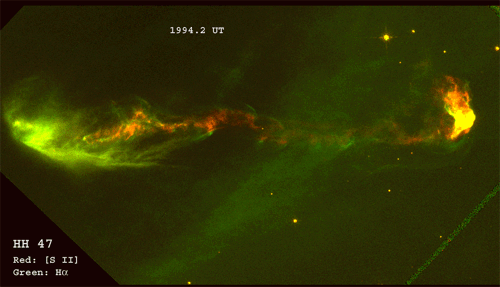New Animation: Hubble Spots Cosmic Traffic Jam

A new animation of a high-speed cosmic pileup has been created using images from the Hubble Space Telescope.
Superheated gas called plasma, spewing from a newborn star, travels in clumps that move at different speeds. Fast-moving, recently ejected clumps sometimes catch up with slower batches that had been sent out previously.
The resulting traffic jams create massive shock waves that travel trillions of miles across the cosmos.
Better understanding
The movie helps astronomers trace the stellar jet, as it is called, in order to better understand it and the newborn star from which it emanates.
The animation was released today and an analysis of it was published in the November issue of the Astronomical Journal.
"When it comes to actually showing exactly what's going on, there¹s just nothing like a movie," said study co-author Patrick Hartigan, associate professor of physics and astronomy at Rice University. "You can look at a still image and make up all kinds of stories, but they all go out the window when you see a movie."
Get the Space.com Newsletter
Breaking space news, the latest updates on rocket launches, skywatching events and more!
Origin of a jet
Stars form out of giant clouds of gas and dust. Within these clouds, gravity pulls material together into a tight ball surrounded by a large spinning disk of material. The disk holds the stuff of planet formation.
Much of the disk material gradually spirals into the star. The resulting energy from this process, which is not fully understood, drives the jets of plasma that erupt from it at perpendicular angles to the spinning accretion disk, which means they shoot out from the stellar poles.
The Hubble images were made in 1994 and 1999. They show the jet streaming from a star named HH 47 in the constellation Vela.
"Our movies give us the ability to track the movement of individual features within the stellar jet, both relative to stationary objects and relative to other objects that are moving within the jet at a different speed," Hartigan said.
- Hubble Space Telescope: Greatest Hits
- Hubble's New Views of the Universe
- Hubble Sees Stars as They're Born
Join our Space Forums to keep talking space on the latest missions, night sky and more! And if you have a news tip, correction or comment, let us know at: community@space.com.

Space.com is the premier source of space exploration, innovation and astronomy news, chronicling (and celebrating) humanity's ongoing expansion across the final frontier. Originally founded in 1999, Space.com is, and always has been, the passion of writers and editors who are space fans and also trained journalists. Our current news team consists of Editor-in-Chief Tariq Malik; Editor Hanneke Weitering, Senior Space Writer Mike Wall; Senior Writer Meghan Bartels; Senior Writer Chelsea Gohd, Senior Writer Tereza Pultarova and Staff Writer Alexander Cox, focusing on e-commerce. Senior Producer Steve Spaleta oversees our space videos, with Diana Whitcroft as our Social Media Editor.









